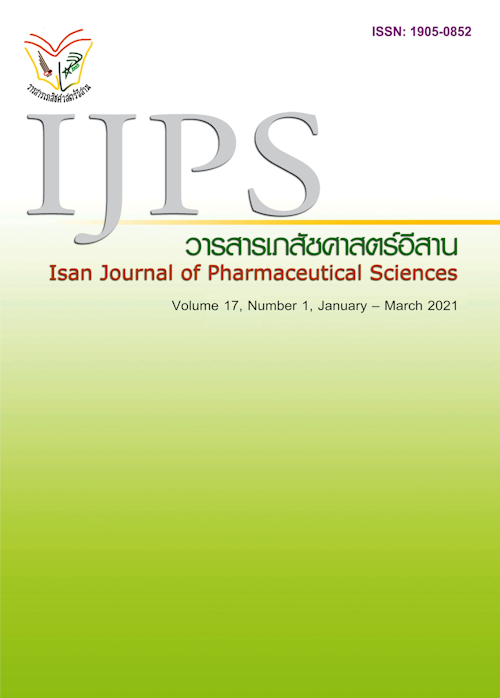Microbiological Limits in Cosmetics
Main Article Content
Abstract
Cosmetics are non-sterile products which can be contaminated with microorganisms in limit numbers and types. If the numbers of microorganisms are excess, the microbes may grow by using ingredients in the products causing physicochemical changes and finally loss in product stability and activity. Excessive microbial contamination is a major problem in cosmetic industry. Standard requirements of United States Pharmacopeia (USP) edition 42, International Organization for Standardization (ISO) 17516: 2014[E] and Thai Herbal Pharmacopoeia (THP) 2019 for microbiological investigations in non-sterile products are quite similar in quantitative and qualitative aspects. However, the names of the test method and test focus are different. The requirement of USP concentrates on “non-sterile products for skin” and “Microbial Enumeration Tests” are the method names, while ISO 17516: 2014[E] uses the method name “Microbiological Limits” and focuses on “cosmetics”. The requirement of THP emphasizes on “non-sterile pharmaceutical products with and without herbs for intact skin” and “Microbial Limit Tests” are the test names. In quantitative aspect, USP requirements for total aerobic microbial count (TAMC) and total combined yeasts and molds count (TYMC) are ≤ 1 x 102 and ≤ 1 x 101 colony forming unit (CFU)/g or ml of product, respectively. The maximum acceptable count is 2-fold which make the numbers are equal to those of the THP (TAMC and TYMC ≤ 2 x 102 and ≤ 2 x 101 CFU/g or ml of product, respectively). Consequently, the requirements of USP and THP are more strict than that of ISO 17516: 2014[E] which combines TAMC and TYMC into ≤ 1 x 103 CFU/g or ml of product. In qualitative aspect, ISO 18415: 2017[E], USP and THP requirements for undesirable specific microorganisms are Pseudomonas aeruginosa and Staphylococus aureus. Additionally, ISO requires more undesirable microorganisms which are Candida albicans and Escherichia coli. The cosmetic requirement for microbiology in an announcement B.E. 2559 of the Ministry of Public Health harmonizes with the aforementioned Pharmacopoeias and ISO except Clostridium spp. is an undesirably added microorganism in products with herb. The methods of microbial enumerations and specific microorganism determinations are different in each standard. This article will focus on the methods of ISO requirement. The evaluations of cosmetic products in microbiological stability and risk are the quality assurances, especially products with low microbiological risk and safe for users would increase the product quality and decrease the necessity in microbial investigation in cosmetics.
Article Details
In the case that some parts are used by others The author must Confirm that obtaining permission to use some of the original authors. And must attach evidence That the permission has been included
References
Bashir A, Lambert P. Microbiological study of used cosmetic products: highlighting possible impact on consumer health. J Appl Microbiol. 2020 Feb; 128(2): 598-605. doi: 10.1111/jam.14479. Epub 2019 Oct 28.
Brannan DK. Chapter 2: Biology of microbes. In: Geis PA, editor. Cosmetic Microbiology: A Practical Approach. 2nd ed. New York: Taylor&Francis; 2006. 19-54. [cited 2020 June 22]. Available from: https://books.google.co.th/books?id=2AiiDwAAQBAJ&pg=PA27&lpg=PA27&dq=hypotonic+cosmetic&source=bl&ots=mBRvsyXpe&sig=ACfU3U1QKczuPh1CrwyPzeuFGrJhxRVgBg&hl=th&sa=X&ved=2ahUKEwimgdi6uZTqAhWX63MBHeFoD6EQ6AEwBXoECAIQAQ#v=onepage&q=hypotonic%20cosmetic&f=false
Centers for Disease Control and Prevention (CDC), National Center for Emerging and Zoonotic Infectious Diseases (NCEZID), Division of Foodborne, Waterborne, and Environmental Diseases (DFWED). Fungal diseases/candidiasis [Online]. 2019 November 13 [cited 2020 March 16]. Available from: https://www.cdc.gov/fungal/diseases/candidiasis/index.html
Centers for Disease Control and Prevention (CDC), National Center for Emerging and Zoonotic Infectious Diseases (NCEZID), Division of Foodborne, Waterborne, and Environmental Diseases (DFWED). E. coli (Escherichia coli) [Online]. 2020 February 26 [cited 2020 March 16]. Available from: https://www.cdc.gov/ecoli/index.html
Centers for Disease Control and Prevention (CDC), National Center for Emerging and Zoonotic Infectious Diseases (NCEZID), Division of Foodborne, Waterborne, and Environmental Diseases (DFWED). Staphylococcus aureus in Healthcare Settings [Online]. 2011 January 17 [cited 2020 March 16]. Available from: https://www.cdc.gov/hai/organisms/staph.html
Ho Sui SJ, Lo R, Fernandes AR, et al. Raloxifene attenuates Pseudomonas aeruginosa pyocyanin production and virulence. Int J Antimicrob Agents 2012; 40(3): 246 – 251. doi:10.1016/j.ijantimicag.2012.05.009. PMC 5511546. PMID 22819149.
International Organization for Standardization (ISO)11930: 2019[E], Cosmetics — Microbiology —Evaluation of the antimicrobial protection of a cosmetic product.
International Organization for Standardization (ISO) 16212: 2017[E], Cosmetics — Microbiology —Enumeration of yeast and mould.
International Organization for Standardization (ISO) 17516: 2014[E], Cosmetics — Microbiology —Microbiological limits.
International Organization for Standardization (ISO) 18415:2017[E], Cosmetics — Microbiology —Detection of specified and non-specified microorganisms.
International Organization for Standardization (ISO) 18416:2017[E], Cosmetics — Microbiology —Detection of Candida albicans.
International Organization for Standardization/Technical Report (ISO/TR) 18811:2018[E] Cosmetics-Guidelines on the stability testing of cosmetic product.
International Organization for Standardization (ISO) 21149: 2017[E] Cosmetics — Microbiology — Enumeration and detection of aerobic mesophilic bacteria.
International Organization for Standardization (ISO) 21150: 2015[E], Cosmetics — Microbiology — Detection of Escherichia coli.
International Organization for Standardization (ISO) 22716: 2007, Cosmetics — Good Manufacturing Practices (GMP) — Guidelines on Good Manufacturing Practices.
International Organization for Standardization (ISO) 22717: 2015[E], Cosmetics — Microbiology — Detection of Pseudomonas aeruginosa.
International Organization for Standardization (ISO) 22718: 2015[E], Cosmetics — Microbiology — Detection of Staphylococcus aureus.
International Organization for Standardization (ISO) 29621: 2017[E], Cosmetics — Microbiology — Guidelines for the risk assessment and identification of microbiologically low-risk products.
Michalek IM, John SM, Santos CD. Microbiological contamination of cosmetic products – observations from Europe, 2005–2018. JEADV 2019; 33: 2151-2157.
The Thai Herbal Pharmacopeia (THP). Department of Medical Sciences, Ministry of Public Health; 2019.
The United State Pharmacopeia (USP) 42 and The National Formulary (NF) 37, Asian edition Volume 4-5, Chapter 61, 1111. Rockville: USP Convention Inc; 2019.
Varvaresou A, Papageorgiou S, Tsirivas E, et al. Self-preserving cosmetics. Int J Cos Sci 2009; 31(3): 163-175.
Tong SY, Davis JS, Eichenberger E, Holland TL, Fowler VG. Staphylococcus aureus infections: epidemiology, pathophysiology, clinical manifestations, and management. Clin Microbiol Rev 2015; 28(3): 603 - 661. doi:10.1128/CMR.00134-14. PMC 4451395. PMID 26016486


